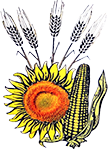Methodological Approaches for Producing Doubled Haploids
in Wheat and Barley at NARDI Fundulea
Alexandru-Leonard Dumitru
Institutul Național de Cercetare-Dezvoltare Agricolă Fundulea
Keywords: doubled haploid, Zea system, Bulbosum system, wheat, barley.
Abstract: Doubled haploids are homozygous plants developed by androgenesis (microspore and antherculture), gynogenesis (ovary and ovule culture), interspecific and wide hybridization. Using doubled haploid technology, it is possible to obtain homozygosity at all loci in a single generation and completely homogeneous breeding lines can be obtained in 1–2 years (one additional year for seeds).
Therefore, this technology may significantly reduce cultivar development time in cereals. At NARDI Fundulea, the generation of haploid plants in wheat is accomplished by wide (intergeneric) hybridization, through „Zea” method and in barley by interspecific hybridization, through „Bulbosum” method. The Zea method rests upon the pollination of wheat by Zea mays L. and Bulbosum method based on the pollination of barley by its wild relative Hordeum bulbosum L.
This work reports the results obtained regarding the production of DH lines in wheat (using Zea method) and barley (using Bulbosum method) at NARDI Fundulea, in two years (2020-2021 and 2021-2022). In this study, a total of 29 winter wheat genotypes and 20 barley genotypes were subjected to the Zea and Bulbosum methods, in order to obtain DH lines for the breeding programs.
For wheat, in 2021, a number of 170 DH lines were obtained from 20 genotypes (F1) and in 2022, 43 DH lines from nine genotypes. For barley, in 2021 a number of 42 DH lines were obtained from 10 genotypes (F1) and in 2022, 28 DH lines from 10 genotypes. Thus, Zea and Bulbosum biotechnological systems are efficient and rapid methods to achieve completely homozygous wheat and barley lines and the doubled haploid lines can be included successfully in breeding programs and in genetic studies.
